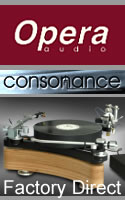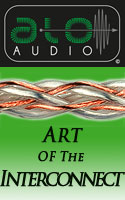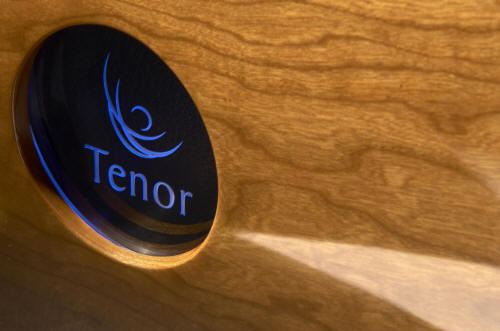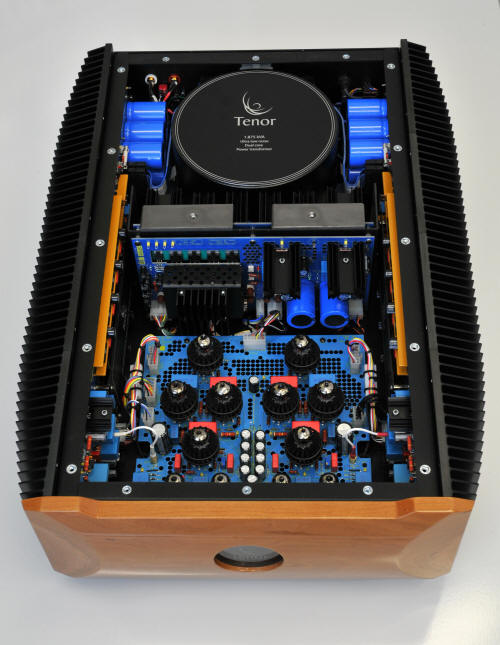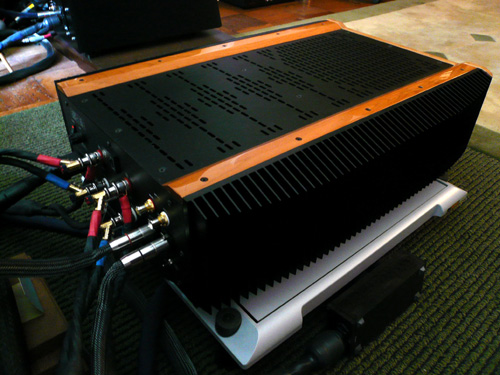|
|
You are reading the older HTML site
Positive Feedback
ISSUE
58
tenor 175S Stereo Amplifier - A High Class Hybrid as reviewed by Marshall Nack
First you encounter the overbuilt shipping case. Then you behold the striking visual of the oddly long and squat amplifier itself, with its gleaming, cherry wood fascia. Now, I've had in my share of exotic and/or pricey components before. The Tenor 175S stereo hybrid is truly imposing looking. It makes a definite statement in the room and will be noticed. It is not one of those units that once set up, disappears into the void. I felt the tingle of excitement building. This was uncomfortable. It violated one of my Ten Commandments—"Thou Shalt Not Fantasize Pre-Positivo,"—one of a list of rules dating from my photography days. To wit: don't start imagining happy outcomes about what's still an undeveloped negative in the film canister (or amp in the shipping crate). This maxim originated a couple of decades ago, when I was pursuing analog photography as eagerly as I now pursue high-end audio.
We set the Tenor upon the TAOC amp stand, after removing the Swiss pacesetter Soulution 710 stereo amp. Wired up, we flipped the two On switches (that's right, there's one in back and one in front) and waited a long three minutes for the red logo to turn blue, indicating it had moved from soft start to ready mode.
Soulution 710 Upon hearing its first sounds, I involuntarily exhaled "Ahhh" as my tension dissipated. The 175S activated my zygomatic major muscles—the ones that make smile—even before it had time to acclimate. My high expectations—after all, where do you go after the Soulution 710?—had been met.
The presence of valves is certainly apparent—nine times out of ten you can pick out the component with them blind. How do you know? To my mind, filaments' positive effects cluster around a single sound byte: they humanize the sound. They take away rough edges, replacing them with soft shoulders. And they throw even order distortions our way, which our ears are quite fond of. There's Detail and Then There's Detail Generally, if you want high res, go with solid-state. But solid-state, high-resolvers are often analytical and harsh. The signal may be the same, but tube resolution is slightly different. Tubes seem to pick among the incoming rush of data and favor those details that are musically relevant and support the music. Solid-state is impartial to the data it passes. This is certainly evident in the tube hybrid 175S, with its 12 valves. It passes a ton of info, nearly as much as the Soulution 710. (This solid-state amp sets the all-time, high water mark for resolution in my house). Detail, in the 175S, means strings have a more woody quality. Vibrato is pronounced. And, beyond the horsehairs of the bow, you can almost detect the rosin. Inner life moves to the forefront; the atmosphere in the listening room perceptibly heats up and becomes intimate. The artifacts of the process recede and you are tuned in to what's important—communication of the musical message. For a good example of this, I cued up an old favorite mono LP from 1955, Ella and Louis (Verve MG V-4003). Now, admittedly, Louis' voice isn't that great. It is ungainly and full of sibilants. You hear oh-so clearly his missed notes. And technically, his trumpet tone is wanting. But somehow, through other expressive means, what comes through the 175S is mighty fine. Louis' voice is so textured, so complex and full of nooks and crannies, he conjures up the image of a muffin—make that an old-timey Thomas' English. Ella is her usual note-perfect self. This is the stuff of legend and, in this system, it is enough to raise goose bumps. I didn't get the same pilomotor reaction with the Soulution. World-Class Tone The 175S has great tone. Body is so full, weighty and thoroughly integrated that the tone has a presence and dimension from its volume and mass. It is hard to explain, but it's different than saying the amp produces 3-D images. In no sense of the word is the Tenor bright. The treble is a little reticent, you may have to help it emerge; the midrange, solid without calling attention to itself, has no outstanding characteristic; bass is very powerful and a little warm. When we switched from the Soulution to the Tenor no voicing or re-balancing was required. These amps have similar tonal balances, overall. I can't say the same for their timbral quality. The valve signature is evident in spades: the Tenor has simply terrific timbre. In addition to enhanced musicality, this helps create the impression of vitality and inner life. World Class Dynamics Dynamics were crazy, knock-your-socks-off, good. Thinking you know what good dynamics are, you put on Dvořák: Symphony No. 9, with the underrated Paavo Järvi conducting the Cincinnati Symphony Orchestra and wait for the first tutti passage (Telarc SACD-60616).
You don't have to wait long. At precisely one minute into the first movement, the pastoral mood is shattered by the first orchestral crescendo. Only it's much bigger than you expect—bigger in terms of sheer sound pressure levels and expansion of headroom. And bigger in terms of involving the entire front of the room. The entire stage is engaged—not just pinpoint locations here and there. Tympani strikes rock the room, unleashing their characteristic long, wave-like action, the kind that you feel in your chest. Now, take note: Within the crescendo some instruments get louder, while others remain at the same level, all per the dictates of the score. It's not like you've turned up the volume and everything increased. That's rather a neat trick! Lately, with these new amps I've had in Lately, when people come over, they comment on how the music swells, how a crescendo grows 'til it fills the room. They begin to move their hands simultaneously forward and outward in a curvy, horizontal V shape, while wearing a somewhat startled expression, like they don't know quite what to make of it. They're not sure how to describe it.
At the end of a session, I'm likely to hear, "You need to get a bigger room. It can no longer hold the sound." It's not because I'm cranking the volume, either. To tell you the truth, we haven't had this quality of dynamic room engagement before—ever. The 175 watts of the Tenor bonded famously with the Main Modules of my YG Anat speakers, helped along by double runs of K-S Elation! speaker wire. This was a match made in heaven and resulted in turbo-charged dynamics and control, definitely giving us a boost along the road to lifelike sound. It was also clear the Anat Main Modules enjoy the extra power. (You wouldn't think that to be the case, given that the Main Modules are 89dB sensitive. In fact, prior to this revelation, I had been contemplating trying some medium-powered tube amps. It doesn't seem like such a good idea in hindsight.) Just to make sure I was correctly attributing this quality to the Tenor, at one point I turned off the Anat's powered subs, so only the Tenor driving the Main Modules were active. Soundstaging A word or two on the 175S's soundstage is in order. It's the kind you can enter and stroll about in. You will be seduced by its heightened transparency. The Neutrality Issue Our reaction to recording after recording was along the lines of, "Wow. The system sure is cooking tonight. The performance on that disc may not be top tier, but the sound sure is." This should clue you in to two things: 1) The 175S produces top-flight valve sound. 2) Undeniably, there was a degree of sweetening going on. I found it tastefully done; its footprint tread lightly on the signal. The Tenor promotes the attractive elements of tube sound while sidestepping most of the undesirable traits. For instance, the filament halo, or nebulous glow, around images is totally missing. Lately, I've been coming around to the notion that valves are mandatory somewhere in the chain. It doesn't seem to matter where you have them: source, amp, or even out of the signal path. As long as a tube device is on, the effects work their way through the AC line and the valves will be heard. Try this: If you have a tubed CD player, turn it ON. Now play some vinyl. OK. Now, turn off the CD and spin the LP again. In my system there is a marked difference. The LP sounds better when the tube CD player is ON.
Setup and Cosmetics The 175S looks like a piece of fine furniture. With its luxurious, cherry wood fascia, it is quite distinctive. Style-wise, it is a cross between retro and modern. The input AC receptacle takes a 20-amp plug. I surrounded it with K-S Elation! wire and placed it on my TAOC amp stand. No need for a power conditioner. It gives off a fair amount of heat, you'll notice the temperature rising when you get within its immediate vicinity. Technical Discussion Tenor amp technology has evolved from the original OTL designs. The first challenge was to retain the "truthfulness" of their award-winning OTL circuit, but mate it with the power of solid-state devices. This necessitated a hybrid.
From the web site: "The first stage of the 175S design is based on the original all tube OTL (Output Transformer-Less) proprietary concept pioneered by Tenor in the late 1990s. This all tube stage provides 10 watts per channel of pure Class A voltage at a relatively high impedance (by speaker standards), which is the ideal input for a bank of MOSFET transistors. The second stage of the 175S circuitry processes this voltage rich 10 watts per channel and provides additional current to increase the power to 175 watts per channel at 8 ohms or 350 watts at 4 ohms (at the speaker terminals) in a Unity Gain configuration." The second big challenge was to protect the consumer's investment by providing non-invasive protection circuitry against major catastrophe, and do it without compromising the purity of the signal. The new amps monitor six harmful conditions and take action when they cross a pre-set threshold.
The wood and metal work of the current generation 350M and 175S hybrids may look similar to the first gen hybrids hp300 / hp150. The solid cherry wood fascia is an integral part of every Tenor product and the chassis' profile hasn't changed much. However, the insides are a complete re-design. Conclusion Well, I won't beat around the bush: the Tenor 175S is the best tube amp I've met. It tickled my fancy from the moment we pushed the ON button. And not only mine. Everyone, without exception, enjoyed it. It joins the Soulution 710 in the rarified Best of Breed group, which is its equivalent in the solid-state department and my reference. (And now I can add the mbl 9008A monoblocks, which I've been listening to for the last month, to that group.) These are equally strong contenders. Sound-wise, they have no weaknesses. Each brings SOTA strengths based on their topology. Which should you choose? It's great to have a choice, (especially since all three are nearly the same, price-wise.) It becomes a matter of taste. Think of the Tenor as you would a summer vacation. It is a respite from your quotidian experience, like going to a beach resort in Cancun, where the atmosphere is warm, relaxing and feels good on your skin. Everybody gets excited about going away on vacation. The question is, could you live there? Most people return home, but some pack up and make the move. I was tempted to do just that. As Jim Fairhead, the president of Tenor, says in a white paper regarding his amplifiers: they "…will change how you listen to music and generally improve your life." The bar is moving for the state of the art in amplifier design. It is a great time for anyone with deep pockets shopping at the high-end of the market. Marshall Nack
175S Stereo Amplifier
Tenor, Inc. US dealer
GTT Audio
& Video
|

